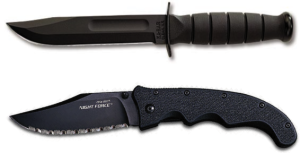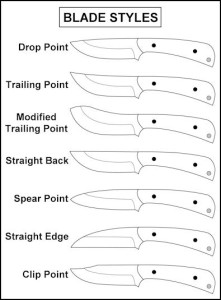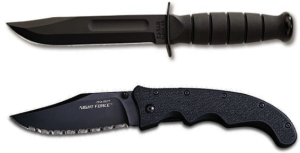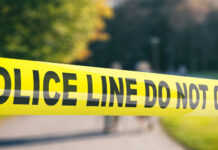Knives are one of those tools and weapons that EVERYBODY has. But the sad fact is this: Most people have the WRONG knife…
And a knife that won’t work when you need it to, or which is unsuitable for the task at hand, might as well be at home in a drawer…
That’s why I’d like to show you how to choose the right knife for Everyday Carry (EDC.) Don’t worry, it doesn’t have to be hard or confusing.
Let’s get started…
STEP #1: Fixed or Folding?

The very first thing you’re going to have to decide is if you will carry a fixed blade or a folding knife.
Here’s the basic rule: Fixed blades are stronger than folding knives. And because they do not have to be opened, they are easier to deploy under stress.
The problem is that legally, a fixed blade knife is less likely to be seen as a utility tool. Folding knives have a long tradition as “pocketknives” and are therefore more apt to be accepted as having some non-martial, utilitarian purpose.
When choosing your knife, the choice of fixed or folding is really up to you, and you can probably make a case for either unless there are laws where you live that make the choice for you.
If you do choose a folding knife, though, make sure it is a reputable brand-name make and of decent quality, with a lock that is strong enough not to fail when you need it most.
STEP #2: Choose The Right Size
Next up you’re going to want to decide on the size and length.
The bigger your folding knife is, the more impractical and the more “weapon like” it’s going to become. Choose a size of knife with which you are comfortable and that fits within the role you have selected for your knife. But the biggest factor on deciding on length will be the law.
What you’ll find is that trying to determine the exact law where you live can be very frustrating. Most knife laws are so vague that they allow a police officer to arrest you or at least harass you for carrying almost anything.
To learn the law, check your state’s penal code (these are often found online, these days; there was a time when you had to schlep your way to the library and look this stuff up in the law books there). Also check for local/municipal restrictions wherever those are located.
But here’s the important thing to remember…
Do NOT ask a police officer, as police officers generally do not know the letter of the law.
STEP #3: Choose The Right Blade Pattern (Very important!)
Next up is the blade pattern. And pay close attention here, because this is very important.
Blade pattern simply refers to the shape of the blade.
A lot of basic bushcraft and survival/utility knives are drop point blades. This just mean the point of the blade is offset, resulting in a blade with more utility than, say, a spear point (which looks exactly like you think it does).
Spear points and drop points are fairly useful for general utility and self-defense. There’s nothing notable about them, really. These are the blade shapes that are simplest.
Wharncliffe blade shapes have a nice, straight edge that is easy to resharpen. They curve down from the spine to the tip, producing a curved forward shape that isn’t as useful for stabbing and penetrating as some other designs.

The clip-point is your classic Bowie knife pattern. It looks like a knife that has a piece lopped out of it at the front, producing a needle-sharp tip and a nice curved belly for slicing. These are excellent for self-defense and generally fairly useful for survival knives.
The tanto blade shape is based on the edge of the Japanese sword, and is most frequently encountered as the Americanized Tanto. This was popularized (but not invented by) Cold Steel. In the Americanized Tanto, two edges meet to form a secondary point. This is bad for slicing (it has no “belly,” or curved portion, for cutting) but very tough and strong, so it penetrates reasonably well. It’s also easy to sharpen, and the secondary point is useful for scoring and utility chores. This is almost always a pattern associated with self-defense, not survival.
There are other blade shapes, but to generalize, an EDC knife used for utility and self-defense will generally give you the best results in a spear-point, drop-point, or clip-point.
An EDC knife used exclusively for self-defense can easily be an Americanized Tanto.
A bushcraft blade or a medium sized knife used for survival will typically be a drop-point or clip-point blade pattern. There are always exceptions and your mileage may vary, of course.
STEP #4: Plain or Serrated?

Here’s the gist of the plain vs. serrated debate:
Serrations are typically of limited value on a survival/bushcraft knife. So if you’re looking for a knife for one of those situations, opt for a plain blade in one of those almost always.
On the other hand, serrations are good for carving through clothing, though, and for grabbing a loose, hanging piece of work like a rope or a cloth.
Plain blades are easier to resharpen. Serrated knives can also be resharpened, but you have to use a sharpening rod to hone each scallop of the serrations individually.
Serrations will keep on ripping even after a blade goes dull, but they really do add maintenance time to the knife, and they make it harder to keep it clean.
I generally prefer plain edges for ease of resharpening and maintenance, but I’ve never not bought a knife simply because it was partially or completely serrated.
So there you have it – four easy steps to make sure you’re prepared in any situation with the right EDC knife.




![How Many Shots Will It Take? [Video]](/wp-content/uploads/2025/06/Depositphotos_2724272_S-218x150.jpg)





![What Level Holster Should You Be Using? [Video]](/wp-content/uploads/2024/04/Depositphotos_44548439_S-218x150.jpg)











![Optic Ready vs Milled slides? [Video]](/wp-content/uploads/2024/02/image-3-218x150.png)
![[Checklist] What Gear You Need To Take Pistol, Rifle & Shotgun Training Courses [Video]](/wp-content/uploads/2023/07/Depositphotos_275087632_L-218x150.jpg)
![What is in Carter’s 2023 EDC? [Video]](/wp-content/uploads/2023/07/Depositphotos_146856137_L-218x150.jpg)










![Optic Ready vs Milled slides? [Video]](/wp-content/uploads/2024/02/image-3-100x70.png)
![[Checklist] What Gear You Need To Take Pistol, Rifle & Shotgun Training Courses [Video]](/wp-content/uploads/2023/07/Depositphotos_275087632_L-100x70.jpg)
![What is in Carter’s 2023 EDC? [Video]](/wp-content/uploads/2023/07/Depositphotos_146856137_L-100x70.jpg)



So what would you say is a good size knife for EDC vs one for, say, a bug out bag?
Comments are closed.